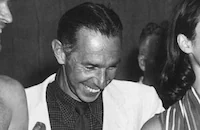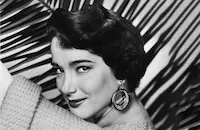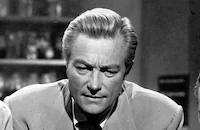Creature from the Black Lagoon

Brief Synopsis
Cast & Crew
Jack Arnold
Richard Carlson
Julia Adams
Richard Denning
Antonio Moreno
Nestor Paiva
Film Details
Technical Specs

Synopsis
In the upper reaches of the Brazilian Amazon, archaeologist Dr. Carl Maia and his team, including Luis, Zee and Chico, excavate a webbed claw from a wall of limestone. Carl rushes the claw to the nearby Instituto de Biologia Maritima, leaving Luis to guard their camp. At the institute, marine life specialist David Reed and his girl friend Kay, amazed with Carl's finding, bring the claw to their boss, Dr. Mark Williams, and the other institute doctors, including Dr. Thompson. After the men agree to fund a more thorough investigation, the group boards the boat of local sailor Lucas to reach the camp. Upon arriving, Carl is devastated to find that a mysterious creature has torn Luis to pieces. No one notices when a webbed hand creeps out of the water toward Kay's leg, disappearing when she walks away. Over the next eight days, the team digs up the limestone but finds nothing, causing Mark, who is eager for publicity-worthy finds, concern about wasted time and funds. One day, David deduces that a lagoon at the end of the river probably holds more fossils. Although Lucas recounts an eery legend about a half man-half fish creature, or Gill Man, that lives in the unexplored Black Lagoon, everyone boards the ship. On board, Mark watches jealously as Kay kisses David. They reach the lovely lagoon the next day, where the Gill Man watches David and Mark as they dive for rocks to test. While Carl discovers that the rocks match the makeup of the limestone, Kay swims out into the lagoon. The Gill Man, fascinated with her beauty, follows her through the water, once touching her foot gently. Before she notices his presence, however, the men call her back, and when the Gill Man pursues her, it becomes tangled in the boat's net. The men struggle to raise the net quickly, but the creature escapes at the last minute, leaving a talon behind. Mark is eager to find and kill the Gill Man, but David urges him to preserve the creature and its natural habitat. They dive, and when the Gill Man attacks them underwater, David takes a photograph and Mark shoots it in the back with a harpoon. On the boat, David chastises Mark, but when his photograph reveals only seaweed, Mark worries that no one will believe their story unless they bring back the Gill Man's body. While the other doctors argue over its existence, the Gill Man drags Chico over the boat and kills him. The next day, Lucas sprinkles the lagoon water with a drug he uses to sedate fish, but the Gill Man avoids the drugged waters. That night, the Gill Man climbs on board to grab Kay, and after her scream scares it back into the drugged water, David follows it, afraid the creature will suffocate underwater. The creature escapes into a grotto, with David close behind and the others on the shore in a rowboat. The Gill Man then circles around to the shore to grab Kay again, and when Tomas tries to stop it, the creature kills him but then collapses. David stops Mark from killing it, instead imprisoning it in a water tank on the boat. Mark's command for the team to leave immediately is vetoed by David, who insists that they stay to complete their experiments. Dr. Thompson stands guard over the creature while the scientists gather more data, but the Gill Man soon escapes his tank and slashes Thompson's face, leaving him near death. The next day, David announces that they cannot risk any more attacks and so must leave. This time, Mark insists that they stay to kill the Gill Man, but Lucas holds a machete to Mark's neck and starts the engine. On the way out of the lagoon, however, they discover that the creature has blocked the boat with a huge log, trapping them. When they cannot clear the log from above, David dives under the boat, followed by Mark, who still wants to kill the Gill Man. The moment it attacks, Mark shoots it with a harpoon. Only slightly wounded, the creature grabs Mark, and although David scares it away, he is too late to save Mark's life. On the boat, David devises a plan to shoot the rest of the drug directly at the creature, hoping to disable it long enough to clear the log. He dives down and surrounds the Gill Man with the drug. As soon as he moves the log and the boat can sail, however, the creature climbs aboard, grabs Kay and dives back into the water with her. David follows them into the grotto, where the still-groggy creature attacks him. Carl and Lucas appear in time to shoot the creature several times with bullets, after which David asks them not to shoot again. They watch in silence as the wounded Gill Man struggles into the water and slowly sinks out of sight.

Director

Jack Arnold
Cast

Richard Carlson

Julia Adams

Richard Denning

Antonio Moreno

Nestor Paiva

Whit Bissell
Bernie Gozier
Henry Escalante
Rodd Redwing
Julio Lopez

Ben Chapman
Sydney Mason
Crew
William Alland
Hilyard Brown
Leslie I. Carey
Ray Craddock
Harry Essex
Fred Frank
Russell A. Gausman
Joseph Gershenson
James C. Havens
Bernard Herzbrun
Ray Jeffers
Al Kennedy
Ted J. Kent
Jack Kevan
Joe Lapis
Russ Maverick
Rosemary Odell
Arthur Ross
William Snyder
Joan St. Oegger
Foster Thompson
Charles S. Welbourne
Bud Westmore
Maurice Zimm

Photo Collections
Videos
Movie Clip



Hosted Intro
Film Details
Technical Specs

Articles
Creature from the Black Lagoon
Originally released in 3-D, Creature From the Black Lagoon would occasionally exploit that unique screen process during the underwater sequences but director Jack Arnold was primarily interested in creating an atmosphere of impending dread. In an interview, the director stated that "It plays upon a basic fear that people have about what might be lurking below the surface of any body of water. You know the feeling when you are swimming and something brushes your legs down there - it scares the hell out of you if you don't know what it is. It's the fear of the unknown. I decided to exploit this fear as much as possible in filming The Creature From the Black Lagoon." Steven Spielberg certainly took a cue from Arnold; his opening shark attack in Jaws (1975) in which we get a tantalizing underwater view of the female swimmer is clearly an homage to Creature From the Black Lagoon.
Interestingly enough, Creature From the Black Lagoon was inspired by a Mexican folk tale. Producer William Alland recalled (in Tom Weaver's collection of interviews, Monsters, Mutants and Heavenly Creatures) a dinner with Orson Welles, Dolores Del Rio and Mexican cinematographer Gabriel Figueroa in which the latter described "this creature that lives up in the Amazon...Once a year he comes up and claims a maiden, and after that, he leaves, and the village is then safe for another year...He [Figueroa] said, 'You people think I'm joking, don't you?' and he then insisted that this was absolutely true, that he could produce photos and this and that...!" Fact or fiction, Alland decided to develop the idea into a movie at Universal.
The real challenge of the film was constructing the gill man costume. A first version of the creature was rumored to look like the Oscar statuette and was promptly abandoned. The winning design turned out to be a foam rubber construction with a latex skin but there have been some discrepancies over the years of who was actually inside the suit. It was actually two actors, stuntman Ben Chapman and champion swimmer Ricou Browning. Chapman, in an interview with the internet fan site, The Astounding B Monster, said, "It's very simple. Anything below the surface was Ricou, anything above the surface was me." Both actors had their difficulties manipulating the costume but Browning probably had the more problematic part, sometimes having to hold his breath for up to five minutes during a take. "If I got to where I was really desperate for air," Browning told Tom Weaver (in They Fought in the Creature Features), "I would just stop everything and go limp, and the safety man would swim in to me and give me an air hose...Compared to what they do today as far as makeup and monsters' faces and so forth, the Creature would be considered the Model T. For instance, I had a little squeeze bulb that I held in my hand, and the tube from it ran up my arm. I could squeeze that and make the gills fluctuate in and out. I could move my lips a little by moving my chin, but the eyes I had no control over whatsoever. It was very crude compared to what they do today." In one of the more amusing production anecdotes, Browning recalled having to make an emergency bathroom visit, emerging from the water in full costume near an unsuspecting mother and her small daughter on the nearby shore. "They took off, and that's the last I saw of 'em!"
Chapman, as the upright, dry land version of the Creature, had a slightly easier time of it than Browning but he did recount one near accident (in Attack of the Monster Movie Makers by Mike Weaver) regarding his fight scene with Bernie Gozier: "He was supposed to swing at me with his machete, and I was going to counter by grabbing his hand. We rehearsed it, and I told him he was going to have to help me; with the helmet on, I couldn't see that well. Well, he came down with the machete, I reached up and I missed his hand - and bang, right on top of my head. Of course, the blade was dull and the top of the helmet was quite thick, so there was no damage."
Julie Adams also shared her impressions and some memories of the film's production (in They Fought in the Creature Features), stating "in the real classics, there always is that feeling of compassion for the monster. I think maybe it touches something in ourselves, maybe the darker parts of ourselves, that long to be loved and think they really can't ever be loved. It strikes a chord within us." As for the actual film shoot, Adams recalled that it "was a very, very pleasant movie, and we all laughed a lot" but there was that one day where she had to swim in freezing water (the studio crew forgot to heat the water tank prior to filming). "I was trying not to shiver as I was lying limp in this poor guy's [the Creature's] arms. And he could barely see, so as he carried me, he scraped my head on a plaster rock and skinned my head. It was not the best morning of the picture!"
Producer: William Alland
Director: Jack Arnold
Screenplay: Arthur A. Ross, Harry J. Essex, based on a story by Maurice Zimm
Art Direction: Hilyard M. Brown, Bernard Herzbrun
Cinematography: James C. Havens, William Snyder
Editing: Ted Kent
Music: Herman Stein, Hans Salter, Henry Mancini, Joseph E. Gershenson (musical director)
Costume Design: Rosemary Odell
Cast: Richard Carlson (David Reed), Julie Adams (Kay Lawrence), Richard Denning (Mark Williams), Antonio Moreno (Carl Maia), Nestor Paiva (Lucas), Whit Bissell (Edwin Thompson), Gill-Man in water (Ricou Browning), Gill-Man on land (Ben Chapman).
BW-80m. Closed captioning.
by Jeff Stafford

Creature from the Black Lagoon
Quotes
I can tell you something about this place. The boys around here call it "The Black Lagoon." Only they say nobody has ever come back alive to prove it.- Lucas
I can tell you something about this place. The boys around here call it "The Black Lagoon;" a paradise. Only they say nobody has ever come back to prove it.- Lucas
Who eats rocks?- Lucas
I eat rocks. I crush and look inside them and they tell me things.- Carl Maia
What do they tell you?- Lucas
How old they are.- Carl Maia
It is impossible. But I, Lucas, will do it.- Lucas
We didn't come here to fight monsters, we're not equiped for it.- Dr. David Reed
Trivia
Ricou Browning, a professional diver and swimmer, was required to hold his breath for up to 4 minutes at a time for his underwater role as the "Gill Man." The director's logic was that the air would have to travel through the monster's gills and thus not reveal air bubbles from his mouth or nose. Thus, the costume was designed without an air tank. In the subsequent films, this detail was ignored and air can be seen emanating from the top of the creature's head.
In this film, the eyes of the Creature were a fixed part of the rubber construction of the suit. The actors who played the part of the "Gill Man" could barely see, if at all. In the second film, the eyes have been, somewhat ludicrously, replaced with large, bulbous fish-eyes to assist in the actor's vision.
Jenny Clack (University of Cambridge) discovered a fossil amphibian, found in the remnants of what was once a fetid swamp and named it Eucritta melanolimnetes - literally "the creature from the black lagoon".
When William Alland was a member of Orson Welles' Mercury Theatre, he heard famed Mexican cinematographer 'Gabriel Figueroa' tell of a legend about a humanoid creature that supposedly lived in South America. That legend became the origin of this film.
The Creature, using the name "Uncle Gilbert", appeared in an episode of the TV series _"Munsters The" (1964)_ The episode is titled "Love Comes to Mockingbird Heights."
Notes
The working title of this film was Black Lagoon. The film begins with a voice-over narration describing the Earth exploding into being, cooling down over millions of years and developing the first forms of life. According to a September 1953 Los Angeles Times news item, Frank Lovejoy was originally cast as "David Reed," but Richard Carlson took over the role. The film marked the second collaboration between star Carlson, producer William Alland, director Jack Arnold and writer Harry Essex, who were behind the hit science-fiction film It Came from Outer Space, produced by Universal in 1953 (see below). Creature from the Black Lagoon was shot in black-and-white 3-D. According to a Hollywood Reporter news item, underwater scenes were shot in Wakulla, FL. Modern sources add that some scenes were also shot on location in Crystal Springs, FL.
Modern sources report that Alland and Arnold based their design for the Gill Man on the Academy Awards Oscar statuette. Modern sources also state that Glenn Strange turned down the role of the Gill Man, which was filled, in the underwater scenes, by Ricou Browning. A September 1953 Hollywood Reporter news item adds Richard Webb to the cast, but he was not identified in the viewed print. Modern sources add Ned Le Fevre to the cast and the following names to the crew credits: Creature des Millicent Patrick; Makeup Chris Mueller; Double for Julia Adams Ginger Stanley; Music Robert Emmett Dolan, Henry Mancini, Milton Rosen, Hans J. Salter, and Herman Stein.
At the time of its release, Creature from the Black Lagoon enjoyed critical and popular success, and has since gained status as one of the most important science-fiction films of the era, with the Gill Man emerging as one of the genre's most iconic monsters. Universal produced two sequels to the picture: In 1955, Revenge of the Creature was again directed by Arnold, while John Sherwood directed the 1956 picture The Creature Walks Among Us (see below). All three films in the series were produced by Alland.
Although LAWeekly announced in May 1982 that producer-director John Landis planned to remake Creature from the Black Lagoon, retaining Jack Arnold as the director and the original design of the creature, that film was not produced. In early 2003, Universal announced new plans to remake the film, but production had not begun as of spring 2005.

Miscellaneous Notes
Released in United States Winter February 1954
Released in United States on Video August 3, 1994
Re-released in United States on Video August 6, 1996
Released in United States July 1989
Shown at Film Forum Summer Festival of Fantasy, Horror and Science Fiction in New York City July 25 & 26, 1989.
Formerly distributed by MCA Home Video.
Swimming champion Ricou Browning played the "Gill-Man" for the underwater sequences.
3-D
Released in United States Winter February 1954
Released in United States on Video August 3, 1994
Re-released in United States on Video August 6, 1996
Released in United States July 1989 (Shown at Film Forum Summer Festival of Fantasy, Horror and Science Fiction in New York City July 25 & 26, 1989.)














